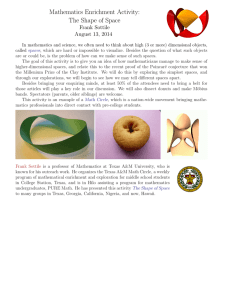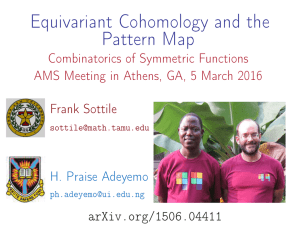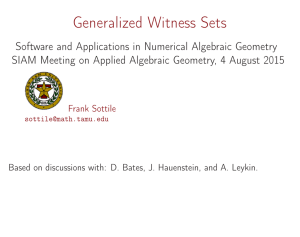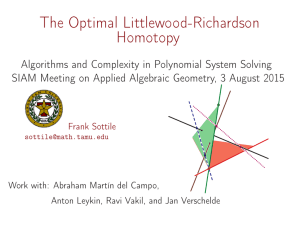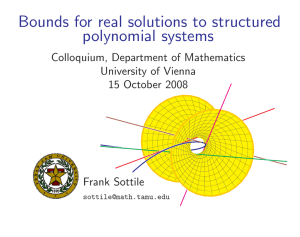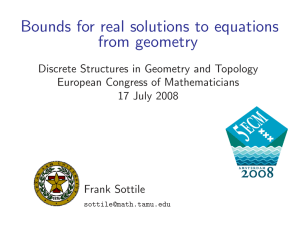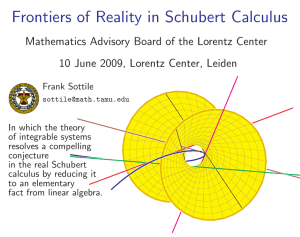Newton Polytopes via Witness Sets Algebraic and Geometric Methods in
advertisement
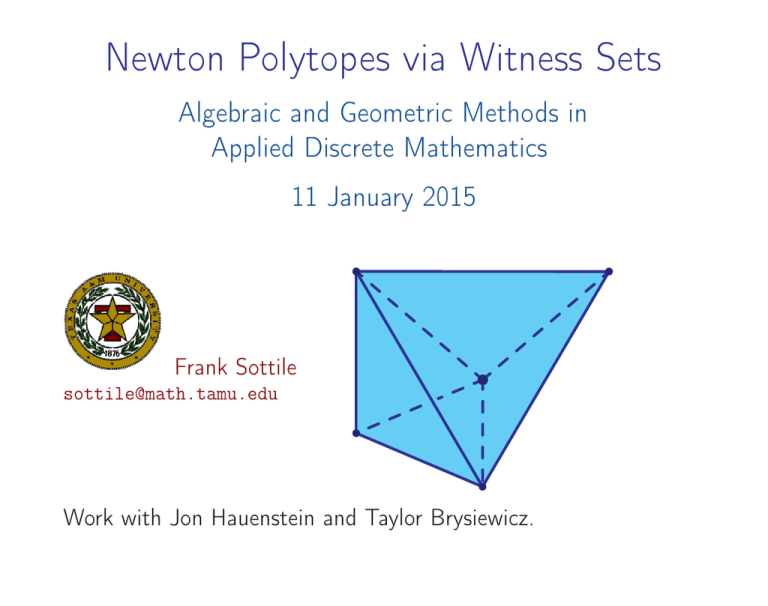
Newton Polytopes via Witness Sets
Algebraic and Geometric Methods in
Applied Discrete Mathematics
11 January 2015
Frank Sottile
sottile@math.tamu.edu
Work with Jon Hauenstein and Taylor Brysiewicz.
Fundamental Problem
By algebraic geometry, an irreducible hypersurface H in Cn is defined by
the vanishing of a single irreducible polynomial, f ∈ C[x1, . . . , xn],
n
H = V(f ) := {x ∈ C | f (x) = 0} .
The problem I want to consider is: Suppose that we know the hypersurface,
but not the polynomial?
= V(f )
f = ????
We would like to understand the polynomial f defining H.
Frank Sottile, Texas A&M University
1
What Does Understand Mean?
Best: Complete knowledge. There are finite sets A ⊂ Zn and
{ca | a ∈ A} ⊂ C such that
X
a
f =
ca x
a
a
a
(x := x1 1 · · · xnn )
a∈A
Pretty Good: Knowing the support, A.
We’ll Settle For: Newton Polytope of H,
N (H) := convex hull of A .
Easier: The degree of H.
Frank Sottile, Texas A&M University
2
How to Know H but not f
The hypersurface H might be the image of a map,
n
ϕ : X −→ H ⊂ C .
This is fairly common, for example
Σ := {(p, f ) | p ∈ P1 , deg(f ) = d , fx(p) = fy (p)}
pr ✂
✂
✌✂
P1
✂
✂ ❇
❇
❇π
❇
❇◆
Pd
pr : Σ → P1 is a projective bundle,
and π(Σ) is the classical discriminant
of a d-form.
Frank Sottile, Texas A&M University
3
Example: Lüroth Quartics
Lüroth, 1869: If ℓ1, . . . , ℓ5 are equations for lines, then
³
q := ℓ1ℓ2ℓ3ℓ4ℓ5 ℓ1 + ℓ1 + ℓ1 + ℓ1 +
1
2
3
4
1
ℓ5
´
defines a quartic that inscribes
the great pentagon,
V(ℓ1ℓ2ℓ3ℓ4ℓ5).
This set of quartics is the image of a map (C3)5− → P14
(P14 = plane quartics),
and it forms a hypersurface, L.
Morley, 1919: L has degree 54.
The defining
equation
of L is the Lüroth invariant, which could have as
¡54+14
¢
many as
= 123234279768160 monomials.
14
Frank Sottile, Texas A&M University
4
How to Represent a Polytope?
P = convex hull of a finite subset of Rn.
\
P =
{x | ω · x ≤ bω },
ω in a finite set
the intersection of finitely many half-spaces.
Oracle Representation:
For ω ∈ Rn, set h(ω) = max{ω · x | x ∈ P }.
The face Pω of P exposed by ω is
Pω := {x ∈ P | ω · x = h(ω)}
The oracle representation of P is a function that given ω ∈ Rn
returns Pω , if it is a vertex.
We propose a method, based on numerical algebraic geometry to compute
an oracle representation of the Newton polytope of a hypersurface.
Frank Sottile, Texas A&M University
5
Witness Sets
Numerical Algebraic Geometry uses numerical analysis to represent and
manipulate varieties on a computer.
Let V ⊂ Cn be a variety of codimension k, given as a component of
F (x) = 0. A witness set for
V is a pair (W, L), where
L
✄
– L is a general affine plane
✎✄
of dimension k, and
✁✁✕
– W = V ∩ L.
▼❇
❇
❇
❇
✻ ✁
✁
❇ ✁
W
✁
✁
V
L is either parameterized, or cut out by n−k affine forms, and W consists
of numerical approximations to V ∩ L.
Frank Sottile, Texas A&M University
6
Continuation
In numerical algebraic geometry, the basic operation is continuation, which
traces points along implicitly-defined paths.
Suppose that L(t) for t ∈ C is a family of k-planes, and we have a witness
set (W1, L(1)) for V .
We numerically continue these points
in V ∩L(t) from t = 1 to t = 0 to
get another witness set (W0, L(0))
for V .
t
0
W0
1
W1
This allows us to sample points from V .
Frank Sottile, Texas A&M University
7
Witness Sets of Projections
Our hypersurfaces come as the image under a projection.
Suppose that X ⊂ Cn ⊕ Cm and H = π(X) ⊂ Cn is a hypersurface.
Hauenstein, Sommese, Wampler: Given a witness set (X ∩ L, L) for X ,
compute a witness set (H ∩ ℓ, ℓ) for H:
— Choose a general lines ℓ ⊂ Cn
— Move L to a non-general plane Λ with π(Λ) = ℓ.
Set W ′ := X ∩ Λ. Then (π(W ′), ℓ) is a witness set for H.
Delicate: Λ is not in general position.
Frank Sottile, Texas A&M University
8
Witness set of a Hypersurface
Suppose f =
X
a
cax is a polynomial, H := V(f ), and P = conv(A).
a∈A
n
Let p, q ∈ C be general, and define
ℓp,q (s) = ℓ(s) := {sp − q | s ∈ C} .
Then f (ℓ(s)) = 0 defines the witness set H ∩ ℓ.
Thus a witness set gives roots of f (ℓ(s)).
For ω ∈ Rn and t > 0, set tω := (tω1 , . . . , tωn ). Then,
X
a
a
ω·a
ω
ca(sp1 − q1) 1 · · · (spn − qn) n t
f (t .ℓ(s)) =
a∈A
!
= t
h(ω)
³X
ca(sp − q)
A∩Pω
a
+
X
a ω·a−h(ω)
ca(sp − q) t
´
ArPw
⇒ ∃dω > 0 such that ω · a − h(ω) < −dω for a ∈ A r Pω .
Frank Sottile, Texas A&M University
9
Main Lemma
ω
f (t .ℓ(s)) = t
h(ω)
³X
a
ca(sp−q) +
A∩Pω
X
a ω·a−h(ω)
ca(sp−q) t
´
ArPw
Set fω to be the sum of terms in f from Pω
Lemma. In the limit as t → ∞, t−h(ω)f (tω .ℓ(s)) → fω (ℓ(s)).
deg(f )−deg(fω ) zeroes will diverge to ∞, while the remaining deg(fω )
remaining bounded.
If Pω is a vertex, say a (which holds when ω is generic), then
fω (ℓ(s)) = ca(sp1 − q1)
a1
· · · (spn − qn)
an
.
Thus ai zeroes of f (tω .ℓ(s)) coalesce to qi/pi as t → ∞.
Our paper describes how to turn this idea into an algorithm.
Frank Sottile, Texas A&M University
10
Lüroth quartics, again
We created a test implementation and used it to compute a few vertices of
the Lüroth polytope (Newton polytope of the Lüroth hypersurface).
Ciani quartics: The Lüroth quartics whose monomials are squares,
4
4
4
2 2
2 2
2 2
αx + βy + γz + 2(δx y + ρx z + σy z ) ,
form a face of the Lüroth polytope, which we computed.
+ α4 β 4 γ 4 ,
It is 14
where
is equivalent to the
bipyramid,
0 1 0 0 1
conv 0 0 1 0 1 =
0 0 0 1 1
Frank Sottile, Texas A&M University
11
Ciani Face of Lüroth Invariant
We used a numerical factorization algorithm and an LLL-based interpolation
method to compute the Lüroth invariant, restricted to this face of Ciani
quartics, f (L)ω .
4
4 4
4
2
2
2
f (L)ω = α β γ f1 f2 f3 f4 · f5 ,
where f1, . . . , f5 have integer coefficients, between 1 and 2401 = 74.
f1, f2, f3, f4 have the same Newton polytope,
f5 has Newton polytope 4
, but
.
Subsequently, Basson, Lercier, Ritzenthaler, and Sijsling found an expression
for the Lüroth invariant in terms of the fundamental and secondary invariants
of GL(3) acting on quartics.
Frank Sottile, Texas A&M University
12
f5
4 4 4
4 3 3 2
4 2 2 4
4
6
4 8
3 4 3 2
2401α β γ − 196α β γ σ + 102α β γ σ − 4α βγσ + α σ − 196α β γ ρ
3 3 4 2
3 3 3
3 3 2 2 2
3 2 3 2 2
3 2 2
3
−196α β γ δ +840α β γ δρσ− 820α β γ ρ σ −820α β γ δ σ +232α β γ δρσ
3 2 2 4
3 2 2 4
3
5
3 2 6
3 2 6
3
7
− 12α β γρ σ − 12α βγ δ σ − 40α βγδρσ + 4α βρ σ + 4α γδ σ − 8α δρσ
2 4 2 4
2 3 3 2 2
2 3 2 3
2 3 4 2
2 2 4 4
+102α β γ ρ − 820α β γ δ ρ +232α β γ δρ σ −12α β γρ σ + 102α β γ δ
2 2 3 3
2 2 2 2 2 2
2 2
3 3
2 2 4 4
2 3 4 2
+232α β γ δ ρσ+128α β γ δ ρ σ − 80α β γδρ σ +6α β ρ σ −12α βγ δ σ
2 2 3 3
2
2 2 4
2
3 5
2 2 4 4
2 3 5
− 80α βγ δ ρσ + 220α βγδ ρ σ − 24α βδρ σ + 6α γ δ σ − 24α γδ ρσ
2 2 2 6
4 6
3 2 2 4
3
5
3 6 2
2 3 4 2
+24α δ ρ σ − 4αβ γρ −12αβ γ δ ρ −40αβ γδρ σ+ 4αβ ρ σ −12αβ γ δ ρ
2 2 3 3
2 2 4 2
2 5 3
4 6
3 5
− 80αβ γ δ ρ σ + 220αβ γδ ρ σ − 24αβ δρ σ − 4αβγ δ − 40αβγ δ ρσ
2 4 2 2
3 3 3
2 4 4
3 6 2
2 5 3
+ 220αβγ δ ρ σ − 272αβγδ ρ σ + 48αβδ ρ σ + 4αγ δ σ − 24αγ δ ρσ
4 2 4
3 3 5
4 8
3 2 6
3 7
2 2 4 4
2 3 5
+ 48αγδ ρ σ −32αδ ρ σ +β ρ +4β γδ ρ − 8β δρ σ+6β γ δ ρ −24β γδ ρ σ
2 2 6 2
3 6 2
2 5 3
4 4 2
3 5 3
4 8
3 7
+24β δ ρ σ + 4βγ δ ρ −24βγ δ ρ σ+48βγδ ρ σ −32 βδ ρ σ +γ δ −8γ δ ρσ
2 6 2 2
5 3 3
4 4 4
+ 24γ δ ρ σ − 32γδ ρ σ + 16δ ρ σ .
Frank Sottile, Texas A&M University
13
The Future
This approach to finding Newton polytopes of hypersurface, and possibly using that information with interpolation to find a defining polynomial appears
feasible, and would have many applications, were a proper implementation
made.
This is a current project of Taylor Brysiewicz, a graduate student at TAMU.
References
[1] R. Basson, R. Lercier, C. Ritzenthaler, and J. Sijsling, An explicit
expression of the Lüroth invariant, ISSAC 13, ACM, New York, 2013,
pp. 31–36.
[2] J. Hauenstein and F. Sottile, Newton Polytopes and Witness Sets,]
Mathematics in Computer Science, 8 (2014), pp. 235–251.
Frank Sottile, Texas A&M University
14
